Nur 101 02 Study guides, Class notes & Summaries
Looking for the best study guides, study notes and summaries about Nur 101 02? On this page you'll find 28 study documents about Nur 101 02.
Page 2 out of 28 results
Sort by
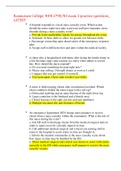
-
Rasmussen College: NUR 2790/N3 exam 2 practice questions_ LATEST,100% CORRECT
- Exam (elaborations) • 41 pages • 2022
-
- $17.49
- 1x sold
- + learn more
Rasmussen College: NUR 2790/N3 exam 2 practice questions_ LATEST ▪ A hospital responds to a local mass casualty event. Which action should the nurse supervisor take to prevent staff post-traumatic stress disorder during a mass casualty event? a. Provide water and healthy snacks for energy throughout the event. b. Schedule 16-hour shifts to allow for greater rest between shifts. c. Encourage counseling upon deactivation of the emergency response plan. d. Assign staff to different roles an...
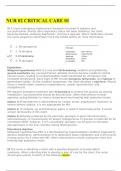
-
NUR 02 CRITICAL CARE 01
- Exam (elaborations) • 114 pages • 2024
-
- $15.99
- + learn more
NUR 02 CRITICAL CARE 01 01A client undergoing endotracheal intubation received IV sedation and succinylcholine. Shortly after respiratory status has been stabilized, the client becomes flushed, profusely diaphoretic, and has a rigid jaw. Which medication should the nurse prepare to administer? Click the exhibit button for more information. 1. IM epinephrine 2. IV atropine 3. IV dantrolene 4. IV glucagon Explanation: Malignant hyperthermia (MH) is a rare and li...
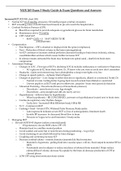
-
NUR 265 Exam 3 Study Guide & Exam Questions and Answers
- Exam (elaborations) • 44 pages • 2022
- Available in package deal
-
- $13.49
- + learn more
NUR 265 Exam 3 Study Guide & Exam Questions and Answers ► What is the normal arterial blood gas (ABG) range for the partial pressure of oxygen (PO2)? o 80-100 mmHg o What if it’s higher than 100? What if it’s lower than 80? ▪ Higher = too much oxygenation … lower = hypoxia ► What is the normal arterial blood gas (ABG) range for the partial pressure of carbon dioxide (PaCO2)? o 35-45 mmHg o What if it’s lower than 35? What is it’s higher than 45? ▪ Decreased = Respirator...
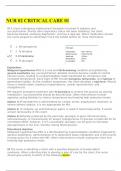
-
NUR 02 CRITICAL CARE 01
- Exam (elaborations) • 114 pages • 2024
-
- $19.29
- + learn more
NUR 02 CRITICAL CARE 01 01 A client undergoing endotracheal intubation received IV sedation and succinylcholine. Shortly after respiratory status has been stabilized, the client becomes flushed, profusely diaphoretic, and has a rigid jaw. Which medication should the nurse prepare to administer? Click the exhibit button for more information. 1. IM epinephrine 2. IV atropine 3. IV dantrolene 4. IV glucagon Explanation: Malignant hyperthermia (MH) is a rare an...
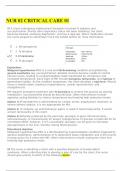
-
NUR 02 CRITICAL CARE 01
- Exam (elaborations) • 114 pages • 2023
-
- $14.99
- + learn more
NUR 02 CRITICAL CARE 01 01 A client undergoing endotracheal intubation received IV sedation and succinylcholine. Shortly after respiratory status has been stabilized, the client becomes flushed, profusely diaphoretic, and has a rigid jaw. Which medication should the nurse prepare to administer? Click the exhibit button for more information. 1. IM epinephrine 2. IV atropine 3. IV dantrolene 4. IV glucagon Explanation: Malignant hyperthermia (MH) is a rare an...
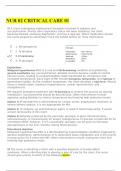
-
NUR 02 CRITICAL CARE 01
- Exam (elaborations) • 114 pages • 2024
-
- $15.49
- + learn more
NUR 02 CRITICAL CARE 01 01 A client undergoing endotracheal intubation received IV sedation and succinylcholine. Shortly after respiratory status has been stabilized, the client becomes flushed, profusely diaphoretic, and has a rigid jaw. Which medication should the nurse prepare to administer? Click the exhibit button for more information. 1. IM epinephrine 2. IV atropine 3. IV dantrolene 4. IV glucagon Explanation: Malignant hyperthermia (MH) is a rare an...

-
NUR 02 CRITICAL CARE 01 | GRADED A+
- Exam (elaborations) • 65 pages • 2022
-
- $16.00
- + learn more
NUR 02 CRITICAL CARE 0101 A client undergoing endotracheal intubation received IV sedation and succinylcholine. Shortly after respiratory status has been stabilized, the client becomes flushed, profusely diaphoretic, and has a rigid jaw. Which medication should the nurse prepare to administer? Click the exhibit button for more information. 1. IM epinephrine 2. IV atropine 3. IV dantrolene 4. IV glucagon Explanation: Malignant hyperthermia (MH) is a rare and li...
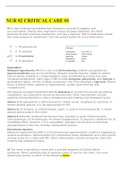
-
NUR 02 CRITICAL CARE 01
- Exam (elaborations) • 114 pages • 2023
-
- $9.99
- + learn more
NUR 02 CRITICAL CARE 01 01 A client undergoing endotracheal intubation received IV sedation and succinylcholine. Shortly after respiratory status has been stabilized, the client becomes flushed, profusely diaphoretic, and has a rigid jaw. Which medication should the nurse prepare to administer? Click the exhibit button for more information. 1. IM epinephrine 2. IV atropine 3. IV dantrolene 4. IV glucagon Explanation: Malignant hyperthermia (MH) is a rare an...
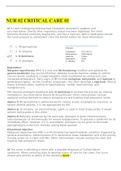
-
NUR 02 CRITICAL CARE 01
- Exam (elaborations) • 114 pages • 2023
-
- $15.99
- + learn more
NUR 02 CRITICAL CARE 01 01 A client undergoing endotracheal intubation received IV sedation and succinylcholine. Shortly after respiratory status has been stabilized, the client becomes flushed, profusely diaphoretic, and has a rigid jaw. Which medication should the nurse prepare to administer? Click the exhibit button for more information. 1. IM epinephrine 2. IV atropine 3. IV dantrolene 4. IV glucagon Explanation: Malignant hyperthermia (MH) is a rare a...
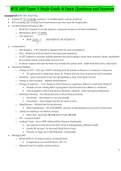
-
NUR 265 Exam 3 Study Guide & Exam Questions and Answers
- Exam (elaborations) • 31 pages • 2023
-
- $12.99
- + learn more
NUR 265 Exam 3 Study Guide & Exam Questions and Answers Increased ICP (939-940, chart 941) • Normal ICP 10-15 mmHg, pressures >20 mmHg impair cerebral circulation • IICP is leading cause of death from head trauma in pts who reach the hospital alive. • Cerebral Perfusion Pressure (CPP) o Blood flow required to provide adequate oxygenation & glucose for brain metabolism o Maintenance above 70 mmHg o CPP= MAP-ICP ▪ MAP= (2xD) + S MAP NEEDS TO BE ATLEAST 80 3 • Compensation o First Resp...

Did you know that on average a seller on Stuvia earns $82 per month selling study resources? Hmm, hint, hint. Discover all about earning on Stuvia


